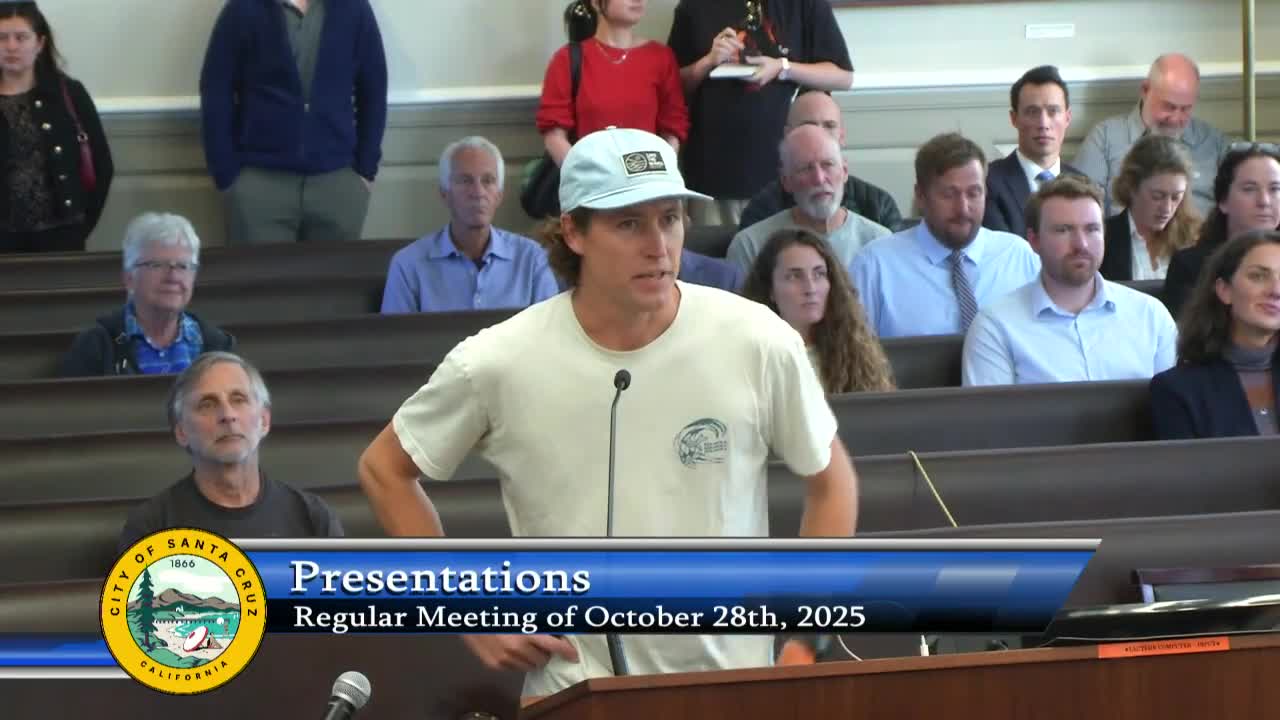Save the Waves study: Santa Cruz surf economy worth roughly $195 million annually; recommends surf‑integrated coastal planning
November 03, 2025 | Santa Cruz County, California
This article was created by AI summarizing key points discussed. AI makes mistakes, so for full details and context, please refer to the video of the full meeting. Please report any errors so we can fix them. Report an error »

Save the Waves presented the findings of a two‑year surf‑economy study and recommended that surf breaks be integrated into coastal planning and the Local Coastal Program. The presenter said the study assessed 31 surf breaks in the Santa Cruz region and quantified visitation, spending and vulnerability to sea‑level rise.
Key findings the presenter cited included 782,000 annual surf visits to Santa Cruz, an average per‑visit spending estimate of about $56, roughly $44.5 million in visitor spending attributed to surfing, and an additional $150 million in general services and surf‑related business activity — for a combined annual estimate of approximately $194.7 million.
The report also modeled "surfability" under sea‑level‑rise scenarios and concluded that increases in sea level reduce the number of surf breaks that are surfable more than half of daylight hours; with one foot of sea‑level rise, the presenter said only seven surf breaks would be surfable more than half the time at ideal tides. The presentation credited local surf condition experts and included outreach with Black Surf Santa Cruz and BIPOC focus groups to assess accessibility and barriers in the surf community.
Presenters urged the council to prioritize surf breaks in planning, add surf language to the local coastal plan (Save the Waves said it submitted comments in February 2024), and consider nature‑based or engineered approaches to preserve surf access where feasible. Council members asked about connections with Visit Santa Cruz County and encouraged using the report as a model for statewide efforts.
Why this matters: The study attempts to quantify an often‑intangible cultural asset and translate it into planning priorities. The economic figures are intended to make a case for protecting surf breaks as part of coastal resilience and permitting decisions.
What's next: Save the Waves said the full 90‑page report is available at savethewaves.org and indicated it will work with city planners on coastal planning and the local coastal program updates.
Key findings the presenter cited included 782,000 annual surf visits to Santa Cruz, an average per‑visit spending estimate of about $56, roughly $44.5 million in visitor spending attributed to surfing, and an additional $150 million in general services and surf‑related business activity — for a combined annual estimate of approximately $194.7 million.
The report also modeled "surfability" under sea‑level‑rise scenarios and concluded that increases in sea level reduce the number of surf breaks that are surfable more than half of daylight hours; with one foot of sea‑level rise, the presenter said only seven surf breaks would be surfable more than half the time at ideal tides. The presentation credited local surf condition experts and included outreach with Black Surf Santa Cruz and BIPOC focus groups to assess accessibility and barriers in the surf community.
Presenters urged the council to prioritize surf breaks in planning, add surf language to the local coastal plan (Save the Waves said it submitted comments in February 2024), and consider nature‑based or engineered approaches to preserve surf access where feasible. Council members asked about connections with Visit Santa Cruz County and encouraged using the report as a model for statewide efforts.
Why this matters: The study attempts to quantify an often‑intangible cultural asset and translate it into planning priorities. The economic figures are intended to make a case for protecting surf breaks as part of coastal resilience and permitting decisions.
What's next: Save the Waves said the full 90‑page report is available at savethewaves.org and indicated it will work with city planners on coastal planning and the local coastal program updates.
View the Full Meeting & All Its Details
This article offers just a summary. Unlock complete video, transcripts, and insights as a Founder Member.
✓
Watch full, unedited meeting videos
✓
Search every word spoken in unlimited transcripts
✓
AI summaries & real-time alerts (all government levels)
✓
Permanent access to expanding government content
30-day money-back guarantee

